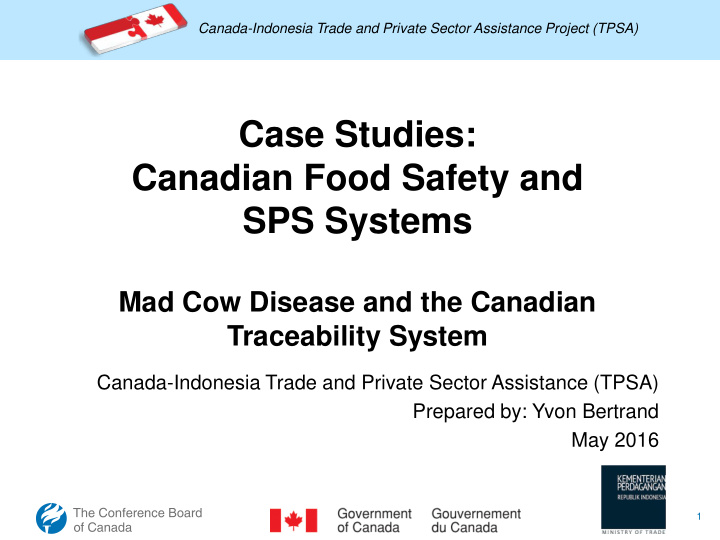



Canada-Indonesia Trade and Private Sector Assistance Project (TPSA) Case Studies: Canadian Food Safety and SPS Systems Mad Cow Disease and the Canadian Traceability System Canada-Indonesia Trade and Private Sector Assistance (TPSA) Prepared by: Yvon Bertrand May 2016 1
Canada-Indonesia Trade and Private Sector Assistance Project (TPSA) Case Study (1) • The discovery of a single reported case of bovine spongiform encephalopathy (BSE), or mad cow disease, on May 20, 2003, had a big blow on Canada’s beef industry . • The discovery led to an immediate worldwide ban on all Canadian beef exports. In September 2003, the United States, followed by a number of other countries, agreed to allow imports of Canadian boneless beef from animals younger than 30 months under a permit process. • As of January 1, 2004, beef producers had a record 14.7 million head of cattle on their farms. This was 1.2 million more than they had at the same time a year earlier. 2
Canada-Indonesia Trade and Private Sector Assistance Project (TPSA) Case Study (2) • Canada could not just slam the door on imported beef products to help offset the domestic oversupply that built up after the world slammed the door on our exports. Notwithstanding the export ban, Canada was obliged under international regulations to continue to allow red meat and livestock imports into the country. • As a member of the World Trade Organization (WTO), Canada is also obliged to accept negotiated quantities of beef from WTO countries. 3
Canada-Indonesia Trade and Private Sector Assistance Project (TPSA) Chronology of Events • August 2003: USA announced a partial reopening of its border (boneless meat from less than 30 months); • January 2004: Canada, USA and Mexico agreed to increase harmonization and equivalence of BSE regulations in North America; • October 2004: USA and Japanese officials reached a framework agreement to set conditions to resume beef trade; • February 2005: USDA conducted an assessment of Canadian ruminant to ruminant Feed Ban. 4
Canada-Indonesia Trade and Private Sector Assistance Project (TPSA) Chronology of Events • April 2005: Mexico, USA and Canada released a harmonized North American BSE Strategy • May 2005: OIE updated its guidelines to reflect latest science, the low risk associated with BSE and the effectiveness of risk mitigation measures; • July 2005: Canadian live cattle shipments were permitted to enter the United States (less than 30 months) for slaughtering. 5
Canada-Indonesia Trade and Private Sector Assistance Project (TPSA) Traceability • December 2005: a Japanese delegation visited a Canadian veal plant to evaluate the traceability program (tagging and movement). • Japan agreed to reopen its border for cattle 20 months or younger. 6
Canada-Indonesia Trade and Private Sector Assistance Project (TPSA) National Traceability program • The CCIA (Canadian Cattle Identification Agency) was established in 1998 to implement animal identification in the cattle industry. Beginning with bar-code tags, industry now has the capability to identify all cattle at a location electronically. • The benefits of the traceability system can be used for food safety, animal health, emergency management, value-chains, and market promotion and access. 7
Canada-Indonesia Trade and Private Sector Assistance Project (TPSA) Attributes The initial system was implemented in Canada based on the proactive foresight of the cattle industry and the federal government at a time when there was no significant health problem in the Canadian cattle herd. Since the initial BSE case in May 2003 affecting a Canadian-born animal, the system has helped in many of the BSE investigations but the lack of movement information in the database has been a limitation in many of the investigations. All BSE investigations require the capability to trace the affected animal back to the herd of origin, as well as tracing the birth cohort, which are all the animals born in the same herd within the timeframe of 12 months before to 12 months after the birth of the affected animal. 8
Canada-Indonesia Trade and Private Sector Assistance Project (TPSA) Principles • Key principles of traceability for the Canadian Industry are: Traceability will support industry standards for commerce. The traceability system for the beef cattle industry will enhance the competitive position of the industry. Traceability will expand as the appropriate technology to support initiatives is available (slowing done auctions). Producer information must remain confidential . 9
Canada-Indonesia Trade and Private Sector Assistance Project (TPSA) Chronology of Events • September 2006: Agriculture and Agri-Food Canada announced the Canadian Integrated Traceability Program (implementation across the value-chain) • March 2008: Canada, USA and Mexico announced an agreement harmonizing North America to OIE standards and allowing Canadian cattle to be shipped through USA and Mexico. 10
Canada-Indonesia Trade and Private Sector Assistance Project (TPSA) Effective Traceability Systems • Three pillars: • Premises Identification • Product Identification • Movement Recording 11
Recommend
More recommend